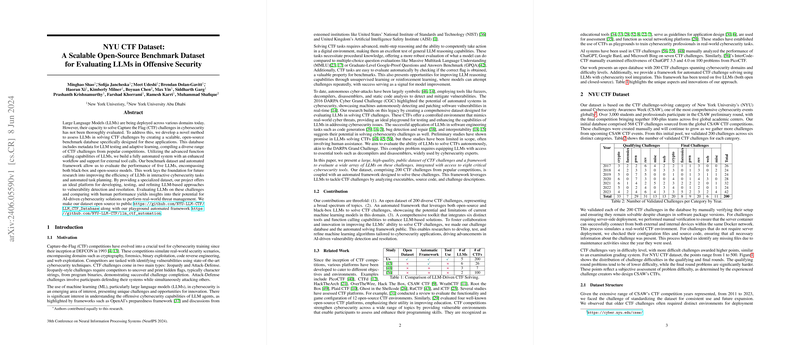A Comprehensive Evaluation of LLMs in Offensive Security through the NYU CTF Dataset
LLMs have seen increasing utilization across various domains, extending their capabilities into the field of cybersecurity. The paper presents a novel approach for evaluating LLMs in the context of Capture the Flag (CTF) challenges—competitive scenarios that simulate real-world cybersecurity tasks. By developing a substantial, open-source benchmark dataset specifically curated for CTF challenges, this research provides an indispensable resource for assessing and enhancing the performance of LLMs in offensive security.
Introduction to the NYU CTF Dataset
The NYU CTF dataset is meticulously designed to accommodate the diverse and intricate nature of CTF challenges. The dataset comprises 200 validated challenges sourced from New York University's (NYU) Cybersecurity Awareness Week (CSAW) competitions. These challenges encompass six distinct categories: cryptography, forensics, binary exploitation (pwn), reverse engineering, web exploitation, and miscellaneous tasks. Each category offers a unique set of obstacles requiring advanced reasoning and technical proficiency, thus serving as rigorous tests for LLMs.
Dataset Structure and Categories
The dataset includes comprehensive metadata for each challenge, detailing its description, difficulty level, associated files, and tools required for solving it. The challenges are designed to mirror real-world cyber threats, and their validation ensures they remain solvable despite changes in software environments over the years. By structuring the dataset in a standardized format and integrating it with Docker containers for dynamic challenge loading, the authors provide a robust platform for systematic LLM evaluation.
Automated Framework for CTF Evaluation
To facilitate the automated evaluation of LLMs, the authors introduce a sophisticated framework that orchestrates the interaction between LLMs and the CTF challenges. This framework consists of five primary modules:
- Backend Module:
- Supports multiple LLM service configurations, including OpenAI, Anthropic, and open-source models via TGI and VLLMs.
- Ensures seamless communication and model inference by leveraging API keys and URLs.
- Data Loader:
- Efficiently loads challenges either from Docker containers or local files.
- Implements a garbage collection mechanism to manage resources effectively, stopping and removing containers post-challenge completion.
- External Tools:
- Enhances LLMs with domain-specific tools such as decompilers, function callers, and command execution utilities.
- Designed to augment the problem-solving capabilities of LLMs in a cybersecurity context.
- Logging System:
- Utilizes rich text Markdown formats for structured logging, aiding in detailed post-execution analysis.
- Captures system prompts, user prompts, model outputs, and debugging information for comprehensive evaluation.
- Prompt Module:
- Constructs system and user prompts based on CTF metadata.
- Facilitates structured interactions ensuring LLMs have the necessary information to attempt solving the challenges.
Performance Evaluation
The evaluation of five LLMs (GPT-3.5, GPT-4, Claude, Mixtral, and LLaMA) across 200 CTF challenges demonstrated varied capabilities. Notably, GPT-4 performed the best overall, albeit with limited success, whereas open-source models like Mixtral and LLaMA did not solve any challenges. This highlights the current gap between black-box commercial models and their open-source counterparts in handling complex cybersecurity tasks.
Comparison with Human Performance
When comparing LLMs to human participants in CSAW competitions, it is evident that while LLMs like GPT-4 and Claude show promise, they still lag behind the median performance of human experts. This underscores the need for further refinement and development of LLMs to enhance their effectiveness in CTF challenges.
Ethical Considerations
Integrating LLMs in offensive security poses significant ethical challenges. The potential for misuse in launching sophisticated cyber-attacks necessitates stringent ethical guidelines and robust security measures. Educating cybersecurity professionals on AI ethics and ensuring the responsible deployment of LLMs are critical to mitigating these risks.
Conclusion and Future Directions
The NYU CTF dataset and the accompanying evaluation framework represent a significant step forward in benchmarking LLMs for cybersecurity applications. However, the authors acknowledge the need for addressing dataset imbalance, enhancing tool support, and keeping pace with advancements in LLM development. Future research should focus on expanding the dataset, incorporating a broader array of challenges, and continuously updating model support to maintain the framework's relevance and utility.
Implications for AI Development
This research has practical implications for advancing AI-driven solutions in cybersecurity. By providing a rigorous benchmark and a detailed framework for evaluation, it paves the way for more sophisticated LLMs capable of tackling real-world cybersecurity threats. The theoretical implications extend to the broader understanding of LLM capabilities in dynamic, multi-step reasoning tasks, highlighting areas for improvement and further paper.
References
A detailed list of references cited in the research can be found in the paper, providing additional context and support for the methodologies and findings presented. The integration of past studies and contemporary advancements underlines the comprehensive nature of this work, grounding it firmly in the current landscape of AI and cybersecurity research.
